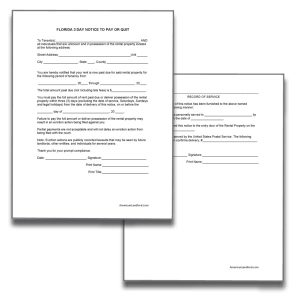Florida Eviction Process
The process for evicting a tenant in Florida is called forcible entry and unlawful detainer action. The information on this page applies only to residential rental property, not commercial or agricultural real estate which may have entirely different proceedings.
1. Complete the proper notice. There are several types of notices a landlord can use to begin the eviction process in Florida. The following are a list of the most commonly used ones:
- Florida 3 Day Notice to Pay or Quit (For nonpayment of rent)
- Florida 7 Day Notice to Cure or Quit (For curable and repeated violations)
- Florida 15 Day Notice to Terminate Tenancy (For month-to-month agreements)
2. Serve the tenant and wait. A landlord must deliver the notice to the tenant and wait the required amount of time for the tenant to either pay the rent, correct the violation, or move.
3. Forcible entry and unlawful detainer action is filed. If the tenant fails to act, the landlord may begin eviction proceedings by filing one of three types of complaints along with the applicable summons with the county court.
Complaint options:
- Complaint for Eviction + Damages – Evicting for nonpayment of rent or other violations as well as claiming damages, such as unpaid rent, repairs beyond wear and tear, etc.
- Complaint for Eviction (Other Violations, No Damages) – When a landlord is wishes to evict for a violation other than nonpayment of rent without claiming damages.
- Complaint for Eviction (No Damages) – Evicting for nonpayment of rent, but without claiming damages.
Summons options:
The landlord is required to provide 4 copies of the notice that is sent to the tenant and pay various fees for the filing, service of process, summons, and eventual writ of possession if the tenant remains on the premises.
4. Serve the tenant with the complaint and summons. The landlord must hire a process server to deliver a copy of the complaint and summons giving a deadline for the tenant to submit an answer.
5. Prepare motions for Clerk’s default and Final Judgment. If the tenant submits an answer, a court date will be scheduled. But if the tenant fails to answer, the landlord must then make 3 copies of the following motions for the court:
If not claiming damages:
If claiming damages:
- Motion for Clerk’s Default with Damages
- Motion for Default Final Judgment with Damages
- Affidavit of Damages
First, the landlord will file the Motion for Clerk’s Default with the Clerk of Court along with a Non-Military Affidavit. Depending on the result of the Clerk Default, the landlord may file the Motion for Default Final Judgement requesting that a judgment be made in their favor due to the tardiness of the tenant’s response. Should they be requesting damages in addition to the eviction, they will need to file an Affidavit of Damages.
Notice to Quit
A 3 Day Notice to Quit demands a tenant to pay the total amount of past due rent.
-
Original price was: $12.95.$9.95Current price is: $9.95.
A 7 Day Notice to Cure or Quit is curable when it’s served for violation that has not been repeated in the past 12 months. If the violation has occurred before, then it becomes simply a notice to quit.
-
Original price was: $12.95.$9.95Current price is: $9.95.
A 15 Day Notice to Quit is served when a landlord desires not to renew a month-to-month rental agreement.
-
Original price was: $12.95.$9.95Current price is: $9.95.


